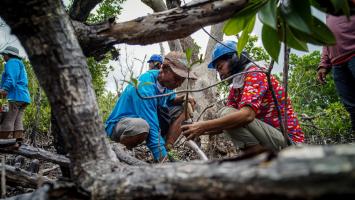Digital Aquaculture Business Solves Hyperlocal Problems and Boosts Income of Fish and Shrimp Farmers

Managing Partner, 500 Global
At the heart of eFishery's success is a business model that leverages data from fish farms to help Indonesian farmers sell their produce better.
This story is published in collaboration with 500 Global.
While his peers in university would rush from one class to the next, a young Gibran Huzaifah El Farizy had to rush between classes to feed the catfishes in his fish farms. One day, he decided to build himself automatic fish feeders that could do the job for him. Little did he know, a decade later, how that invention would become the catalyst for something great.
A team that previously raised what it shared is the world’s largest aquaculture funding round in 2022, Indonesia-based eFishery is today valued at $1.4 billion following a successful $200-million Series D funding from existing investors, 500 Global, Temasek, Softbank, Northstar, as well as new investors 42XFund, Kumpulan Wang Persaraan (KWAP), and responsAbility.
A difficult start
Gibran gained success the hard way. Feed-related costs make up 70%–90% of the total cost of production for fish farmers. He knew that managing this single cost alone would make the difference between failure and success of the fish farm. Once he saw the success he had with his own fish farms, he set out on a journey to provide this technology to all the fish farmers that would need it.
In the early days, selling Internet of Things (IoT) technology to fish farmers was not easy. Selling that story to investors that live in cities was even harder. I remember our early conversations to get more farmers to adopt IoT farming solutions. “What if we loaned the IoT to them? Can we earn money another way?”
Gibran’s business model experiments eventually worked. He found a way to leverage data from the fish farms to help farmers sell their produce better. Once the business model was proven, investors started to take notice.
500 Global invested in eFishery’s Series A funding round in 2018. From 2019 onwards, the company’s revenue kept growing from millions to hundreds of millions, while maintaining 4 years of consecutive EBITDA (earnings before interest, taxes, depreciation and amortization) profitability. I believe eFishery has proven that you can have both scale and profitability, a balance that very few unicorns in the world have done successfully.
Building a billion-dollar company
eFishery built an ecosystem starting with hardware for the aquaculture industry, just as Apple built its ecosystem starting with hardware for the consumer electronics industry. For eFishery, it starts with their eFeeder.
eFeeder. The eFeeder is an IoT-driven automated feeding device enabled by motion and acoustic sensors that optimizes the process of feeding fish and shrimps for aquaculture farmers. Farmers have access to it through a paid subscription, and this allows eFishery to collect key data points such as feeding frequency, feed volume, yield volume, pond quality, pond quantity, and farmer profile, among others.
A year after 500 Global’s investment, the company was serving 20,000 fish ponds. Today, the eFeeder is installed in around 280,000 ponds across Indonesia, with the goal of reaching one million aquaculture ponds by 2025.
eFeed. eFeed is a feed marketplace where farmers buy their preferred feed directly from feed distributors. The integrated ecosystem has been instrumental in supporting over 70,000 fish and shrimp farmers in 280 cities across Indonesia.
eFresh. eFresh sells the fish farmer’s harvest to upstream buyers (business-to-business [B2B] companies, wholesale traders, processing companies) and downstream buyers (modern trade, general trade). According to the company, the service has facilitated the sales of over 100,000 tons of fish and shrimp, and has more than 3,000 B2B export buyers across four countries.
eFund. eFund enables access to financing for farmers by connecting them with banks and peer-to-peer (P2P) lenders to increase their working capital.
Standalone, each of the above business segments could provide immense value to aquaculture farmers. However, I believe a key success factor of eFishery’s ecosystem is that each business segment creates flywheel effects with the potential to increase their overall competitive advantages, and enables the team to expand their offerings down the line.
Impact beyond eFishery
Some of the world’s most pressing issues require technologists and innovators to step up. Aquaculture can play a huge role in addressing some of the issues outlined in the United Nations 2030 Sustainable Development Goals. This includes goals such as zero hunger, climate action, reduced inequalities, and responsible consumption and production. Food security is currently one of the most important topics, and as companies like eFishery demonstrate impact at scale, more nations see hope.
Furthermore, I believe that the next billion internet users will come online primarily from rural areas. This will allow companies, such as eFishery, to serve groups like freshwater fish farmers and increase their incomes, leading to a positive ripple effect on rural development.
What eFishery pioneered in Indonesia is a model we believe they will soon take to other top freshwater fish farming markets around the world.
An inspiring journey
From the moment I met Gibran, I knew that he was going to have a tough journey ahead. He chose a hard problem to solve, one that not many understood. He chose to build his company while being profitable, to buck the trend. He chose to keep his people, culture, and DNA close to the farmers he serves. eFishery’s headquarters is still in Bandung, a second city, and not Jakarta, the capital of Indonesia.
While the recent fundraising round is an important milestone, a testament to his perseverance and financial fundamentals, he would tell you that his work is far from done. We intend to continue to be there alongside Gibran to support him where we can in taking what he has proven in Indonesia to more parts of the world. We believe that eFishery’s journey will inspire more of us to have a positive global impact through solving hyperlocal problems.
Some folks believe the rest of the world copies Silicon Valley. However, I believe that eFishery has truly proven to be unique in terms of business model innovation, proving the trifecta of scale, growth at scale, and profitability over a multi-year period, even before becoming a company valued at over a billion dollars. This is the kind of business Silicon Valley can strive to create.
This article was first published by 500 Global on 10 July 2023.

Khailee Ng
Managing Partner, 500 GlobalKhailee Ng is a managing partner at 500 Global, a multi-stage venture capital firm with $2.5 billion in assets under management that invests in founders building fast-growing technology companies. Khailee has led over 300 investments in startups across Southeast Asia. 500 Global is a leading technology investor in the region having invested early in companies valued at over $1 billion such as Grab, Carsome, Carousell, Bukalapak, FinAccel, and eFishery.

500 Global
500 Global is a venture capital firm with $2.4 billion in assets under management that invests in founders building fast-growing technology companies. It focuses on markets where technology, innovation, and capital can unlock long-term value and drive economic growth. It works closely with key stakeholders and advise governments and corporations on how best to support entrepreneurial ecosystems so startups can thrive.


